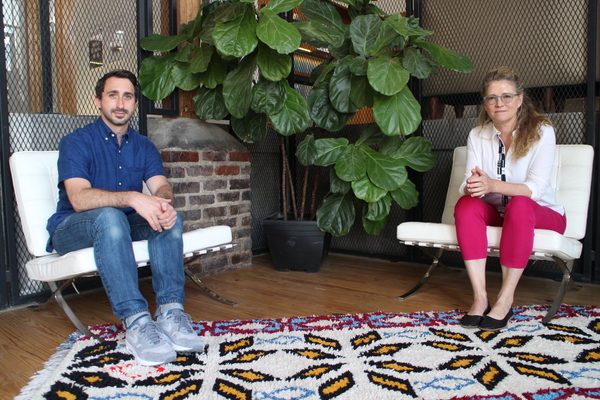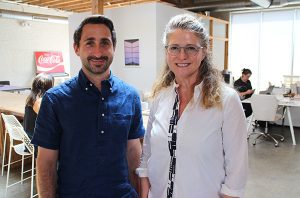Richmond Biz Sense Round Up Studiocenter Arts and Letters

Arts & Letters' newest executive artistic directors, Jed Grossman and Danielle Flagg.(Jonathan Spiers)
When Arts & Letters Creative Co. arrived on the Richmond advert scene last year, the bureau claimed 1 executive creative director: founder Charles Hodges, who was joined by a leadership team of Martin Agency vets and fellow Brandcenter alums.
Six months later, information technology added ii more: ECDs Danielle Flagg, a Wieden+Kennedy vet, and Jed Grossman, well-nigh recently at B-Reel in New York.
The two never had met when Hodges invited them to join the Arts & Letters fold. In fact, they said, neither knew that Hodges was talking to the other or would ultimately bring on a 3rd ECD.
"That was a curiosity," Flagg said, "of, 'Oh! How exactly would that work?'"
At present, six months on the chore, Flagg and Grossman piece of work with Hodges every bit an ECD trifecta, collaborating on some projects and branching off on others. It's an executive-level artistic leadership structure rarely seen in agencies their size, but they say it fits perfectly with Arts & Messages' "make upwards the rules as you get" approach.
BizSense sat down with Flagg and Grossman to learn how they work as a squad, their respective approaches to the creative process, and what inspired them to brand the move to Richmond. The following is an edited transcript:
Richmond BizSense: What made you want to move from New York and Los Angeles to join Arts & Letters? Why was this worth the leap?
Danielle Flagg: Office of it'south but the adventure and the non knowing, merely doing that with people who I very much respect – who accept had some feel and incredible track records, and who are merely good people, express on the politics, the hierarchy.
Jed Grossman: A lot of it is location. I don't retrieve I realized that before I got here, simply being isolated a little flake from the majority of the advertising and creative community in New York, Chicago, L.A., information technology requires u.s.a. all to stretch our brains a footling bit more. And when we're finding people to join us, you take to really want information technology, considering information technology's a little dissimilar than what you're used to. I retrieve that adds to the magic of Arts & Letters, but I'd argue it probably adds to the magic of all of the shops in Richmond as well.
RBS: Most agencies have but 1 executive creative director. How does it piece of work with three?
JG: Historically I've seen it work multiple ways. I call up information technology actually depends on the people. In our situation, the way we work, nosotros all are democratic with the work in front of united states of america, merely then nosotros come together and collaborate when we need to and when it feels right.
DF: The pocket-size gene, the few people we have here, makes people want to exist even more collaborative and connective about building something, considering we all want the success for the entire place. The larger agencies can become – the more than you're focused on your own piece of work and function and success – very siloed.
RBS: What'south your artistic procedure? Accept you developed a detail arroyo or steps you take to tackling a project?
DF: The thing about this place is I don't know that there is ever one approach. On the one hand, when nosotros practice briefs, we want to make certain everyone's involved in the cursory – the producer, project manager, maybe even an editor. We want to accept a lot of people, not just the creatives in a brief. Other times, information technology'll exist over Slack. We'll take half an hour, the whole agency, and, "We need this music rails." And it'll be this really collaborative, democratic, throw-your-ideas-in, and that tin can be for music or for a concept, a footling minibrief where yous put your headphones on for half an hour and everybody is individually making something and submitting it.

Grossman and Flagg in Arts & Letters' Scotts Add-on space.
It's like pieces of the pie, the process, and it changes. That's the thing: we're making upwards our rules as nosotros get, and that's what we beloved.
JG: We're not afraid to milkshake up our squad structure. That's a big office of our process. What defines a traditional creative team is: fine art managing director, copywriter, and yous have those siloed stacks on tiptop of information technology, and you lot have the support squad underneath information technology. Here, it's not uncommon for us to cursory an art managing director, a writer, an editor, and a UX designer at the same time and await them all to exist office of the conceptual phase and not wait for their moment.
RBS: Have yous ever had a project that was the ane that got away? Where people didn't see eye to eye, or you weren't able to execute your vision?
DF: There is one account that was definitely tough in the end, which was Starbucks, when I was at Wieden+Kennedy. We had a whole entrada for them, and they wanted to test it in Detroit. That was a real sad thing to me in the finish, that they couldn't put the energy behind what their total brand story and vox was.
Ultimately Dan Wieden said, "I think we demand to get carve up means." They didn't go abroad; the dance partner thing only didn't work in the finish. It all the same was emotional for me. You feel so invested and excited most how a make tin can exist portrayed out in the world. Patently Starbucks is an incredibly beloved brand, so it wasn't like they needed us, but nosotros really wanted to tell their story in a time when they were becoming more ubiquitous and on every street corner.
RBS: Yous don't hear that so often, where if the agency can't get to what it sees can and should exist done, it would walk away.
DF: Information technology creates a level of integrity nearly who you choose equally your clients. The client-agency human relationship, that's why information technology'due south a relationship – it's two sides trying to work toward something together, every bit opposed to 1 side demanding something and the other simply providing it as a vendor.
Dan Wieden was a very inspirational person to me in that style, to exist able to talk honestly to a client, not fearing that he'll upset them but really that he just wants to ask honest questions and take them ask really honest questions of themselves, and push button us and push the work.
RBS: If you could ask one person a question right at present, who would that person exist and what question would yous ask?
DF: David Bowie is one. He was a major influence in my growing up, and the idea of change and evolving and probably a mercurial way of presenting your life and telling stories. I don't know what I would ask him. And Joni Mitchell, to me, was a huge inspiration in terms of lyrics and artistry. She was a force of nature, and I would probably ask her: Why didn't yous run for some political role (so) that you could effect change?
JG: I was simply talking almost Mr. Rogers, Fred Rogers. It's interesting to me of someone who was then creative and then ahead of their time, I recall both in ideals and was committed to information technology to the cease. I don't know what the question I would ask him would be, merely there's something interesting to me near someone who was so committed. As a new parent but also as a creative, he'south someone who comes to peak of heed.
Source: https://richmondbizsense.com/2018/10/01/creative-qa-ecd-trifecta-adds-arts-letters-alphabet/